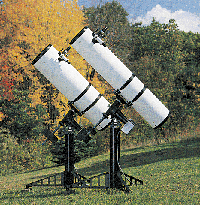 Venus at noon (Mel Bartels)
8k jpg
Venus at noon (Mel Bartels)
8k jpg
 2 images of Mars (Dean W. Armstrong)
html
2 images of Mars (Dean W. Armstrong)
html
 Jupiter (Dean W. Armstrong)
15k jpg
Jupiter (Dean W. Armstrong)
15k jpg
 Saturn (D. Armstrong)
9k jpg
Saturn (D. Armstrong)
9k jpg

To find the planets, you'll need to know where to look. Refer to Sky & Telescope or a similar magazine for up to date positions or check Mike Harvey's online sky charts. A planetarium program (such as Starry Night for the Mac or SkyMap for PCs) can also be useful, especially for the moons.
The tables below are ordered by visual magnitude ("Vo"; bigger numbers are dimmer); this is the maximum brightness that the object attains (approximately when it is closest to Earth). "Date" is the date of discovery.
| Name | Vo |
|---|---|
| Sun | -27 |
| Earth | |
| Moon | -13 |
| Venus | -4.4 |
| Jupiter | -2.7 |
| Mars | -2.0 |
| Mercury | -1.9 |
| Saturn | +0.7 |
| Name | Date | Vo | Discoverer |
|---|---|---|---|
| Ganymede | 1610 | 4.6 | Galileo Galilei |
| Io | 1610 | 5.0 | Galileo Galilei |
| Europa | 1610 | 5.3 | Galileo Galilei |
| Uranus | 1781 | 5.5 | William Herschel |
| Callisto | 1610 | 5.6 | Galileo Galilei |
| Neptune | 1846 | 7.8 | Johann Gotfried Galle |
| Titan | 1655 | 8.3 | Christiaan Huygens |
| Name | Date | Vo | Discoverer |
|---|---|---|---|
| Rhea | 1672 | 9.7 | Giovanni Domenico Cassini |
| Tethys | 1684 | 10.2 | Giovanni Domenico Cassini |
| Iapetus | 1671 | 10.2 | Giovanni Domenico Cassini |
| Dione | 1684 | 10.4 | Giovanni Domenico Cassini |
| Phobos | 1877 | 11.3 | Asaph Hall |
| Enceladus | 1789 | 11.7 | William Herschel |
| Deimos | 1877 | 12.4 | Asaph Hall |
| Mimas | 1789 | 12.9 | William Herschel |
| Triton | 1846 | 13.5 | William Lassell |
| Pluto | 1930 | 13.6 | Clyde W. Tombaugh |
| Titania | 1787 | 13.7 | William Herschel |
| Oberon | 1787 | 13.9 | William Herschel |
| Amalthea | 1892 | 14.1 | Edward Emerson Barnard |
| Ariel | 1851 | 14.2 | William Lassell |
| Hyperion | 1848 | 14.2 | William Cranch Bond |
| Janus | 1966 | 14.5 | Audouin Dollfus |
| Umbriel | 1851 | 14.8 | William Lassell |
| Himalia | 1904 | 14.8 | C. Perrine |
Its easy to see a few of the brighter asteroids with binoculars. Several hundred can be seen with small telescopes.
If you're out at night under a clear sky, you are pretty likely to see a meteor. You may see dozens of meteors if you catch one of the regular meteor showers.
You can even see the interplanetary medium if you're close enough to the poles to see an aurora or if you see the zodical light or the gegenschein.
You can also see the stars 51 Pegasi, 70 Virginis and 47 Ursae Majoris which probably have their own planets, though of course, you can't see the planets themselves.
 Venus at noon (Mel Bartels)
8k jpg
Venus at noon (Mel Bartels)
8k jpg
 2 images of Mars (Dean W. Armstrong)
html
2 images of Mars (Dean W. Armstrong)
html
 Jupiter (Dean W. Armstrong)
15k jpg
Jupiter (Dean W. Armstrong)
15k jpg
 Saturn (D. Armstrong)
9k jpg
Saturn (D. Armstrong)
9k jpg